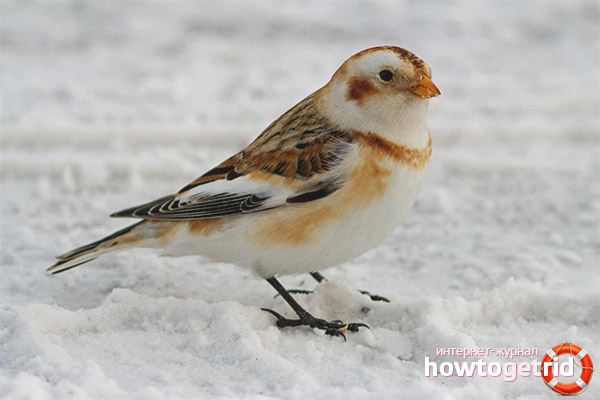The content of the article
The bunting is also called white sparrows; they live preferably in cold climatic regions. Due to the fact that individuals in terms of their external characteristics are whitish, they merge perfectly with the snowy expanses and can easily be masked.
Description and habitat
- When representatives of the male half dress up in a wedding dress, their plumage on the wings and on their back is pigmented in black. The extreme and middle steering feathers are painted in the same color. In the rest of the body, these birds are whitish.
- Females have all those parts that are males black, grayish with a brown tint. Feathers of this color extend to the head, and are also located on the neck like a necklace.
- In the winter, the color of the hull changes. Where the feathers are dark, light portions appear (with the exception of the edge). The beak acquires a yellow-orange hue. In general, the color of the plumage of the hull resembles a snow thaw.
- When the nest building period begins, these individuals choose the tundra as the habitat of the family and future offspring. They prefer to settle on the northern coast near Iceland, as well as the United States of America, Siberia, Canada, Scandinavia. Birds can be found on the Bering Islands. Individuals can inhabit south, for example, near Scotland.
- The represented family lives, if necessary, near water marine sources. It is also extremely important for them to have rocky areas covered with lichens. In some cases, they can build nests on mountain peaks with a small amount of vegetation. They even live at an altitude of 1 km. from sea level.
Nutrition
- The basis of the diet of the birds of the breed group under discussion is composed of seeds, grains, grass, tree buds and various insects.
- In the summer, flying insects fall into the cold area where birds live. They are feathered and eat when pests freeze.
- Sandworms perceive food as a gift from heaven, so they attack it in flocks. Birds collect insects and give them to the chicks so that they quickly grow and develop.
Breeding
- These individuals arrive at nesting sites rather early. In the beginning of spring or when the wonderful time is drawing to a close and summer is coming.
- The end of spring and the beginning of summer signals that it is time for the birds to transform into their mating plumage. Male individuals are painted in black and white, after which they occupy their territory.
- It is at the beginning of the mating season that the birds break in flocks, then proceed to the construction of a dwelling for future offspring. They sing songs, show themselves in all their glory.
- The future mother builds a house on the basis of moss, dry grass, stalks and lichen. Then the cavity of the nest is lined with feather padding or wool. In the clutch there are about 6 eggs, the color of white-green speckled. Chicks are born after a fortnight.
Lifestyle
- Such birds arrive at nesting sites in early spring. Often in such areas snow still lies. Individuals try to stay in small flocks. The considered birds mainly live in the Arctic. When they fly to these places, this indicates that spring is coming.
- Unlike most buntings, these birds are omnivores. When the bugs arrive at the nesting sites, the males begin to sing actively. Such a phenomenon is rarely seen in flight. Toking often occurs on cliffs and stones.
- Males always fly first to nesting sites. Only after 2-3 weeks do the females tighten.Once all the snow has melted, the birds begin to form pairs. After that, adults try to evenly distribute throughout the tundra.
- It is worth noting that the considered individuals during nesting prefer dry rocks, rocky areas, river and steep sea shores when building the nest. Such birds always try to nest in shelter.
- Birds were often seen in crevices of rocks, litter, burrows of lemmings, crevices of buildings and under roofs of houses. The nest is often constructed from plant material. As a result, it turns out to be quite massive, but loose. Feathers, wool and artificial materials are used as insulation litter.
- Often, such birds lay a maximum of 6 eggs. They may have a pale green or bluish color. In addition, the surface can be decorated with rust spots. Separately, it is worth mentioning that the female is exclusively engaged in the construction of the nest and the hatching of future offspring. Often in a year you can find 2 masonry.
- During wintering and seasonal migrations, buntings are often found in open areas. It is worth noting that most buntings return to their habitat. However, this is not characteristic of buntings. In some areas, very unusual species of such birds were discovered.
- The body size of the individuals under consideration often does not exceed 14 cm. As for the physique, the sandworms are somewhat similar to small finches. When the mating season begins, the male acquires a blue-blue outfit. In autumn, the feathered birds have a better disguise.
Interesting Facts
- Most people who have ever seen bugs in the depths of the mainland were often mistaken. They came across simple albino sparrows. Such individuals are quite common. It is worth noting that the wings have a black color in the bugs.
- In some cases, the considered individuals even lead a sedentary lifestyle. This applies to Icelandic birds, who try to stay in one place all year round.
Since ancient times, individuals of the group under discussion have been called Snow Maiden. In nesting places, these birds appear in late spring. Today's material is dedicated to these unique birds, their lifestyle, methods of nesting and food.
Video: buntochka (Plectrophenax nivalis)











Submit